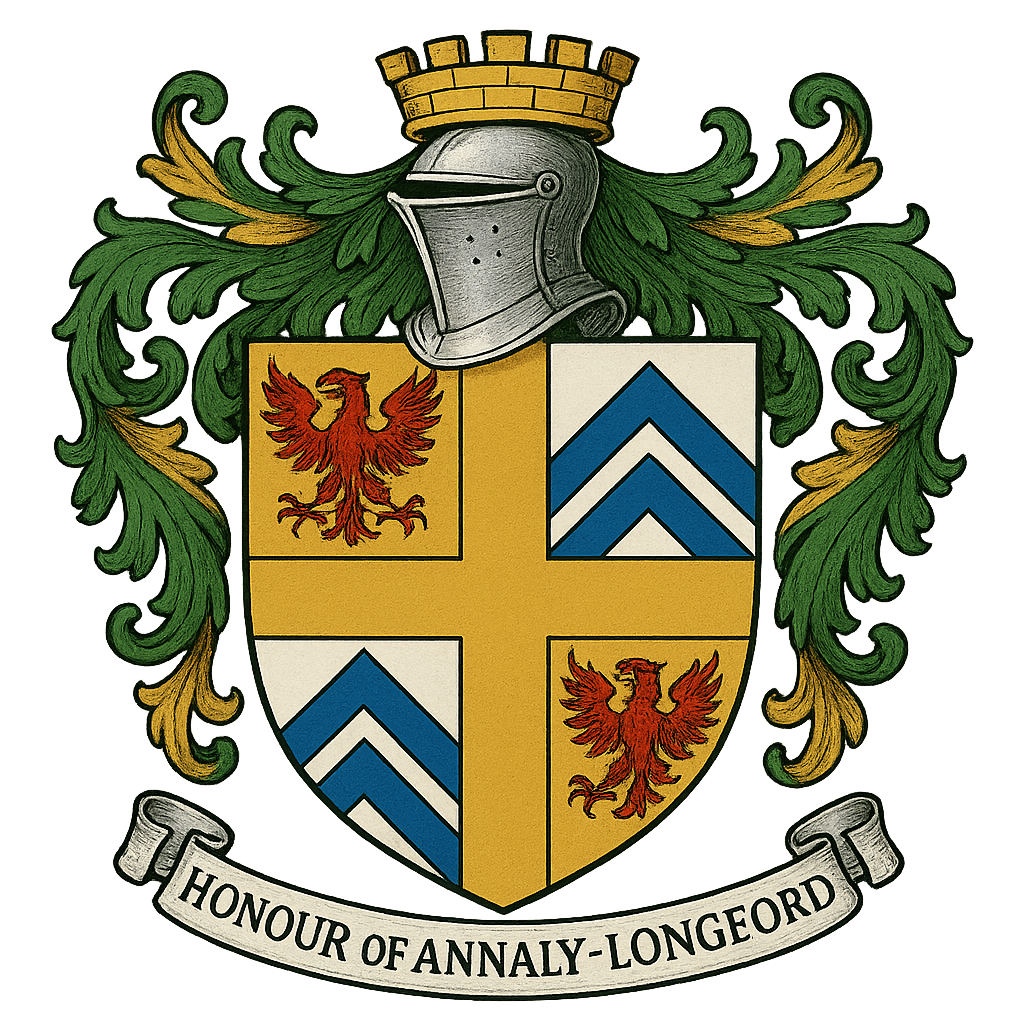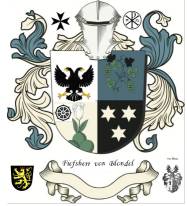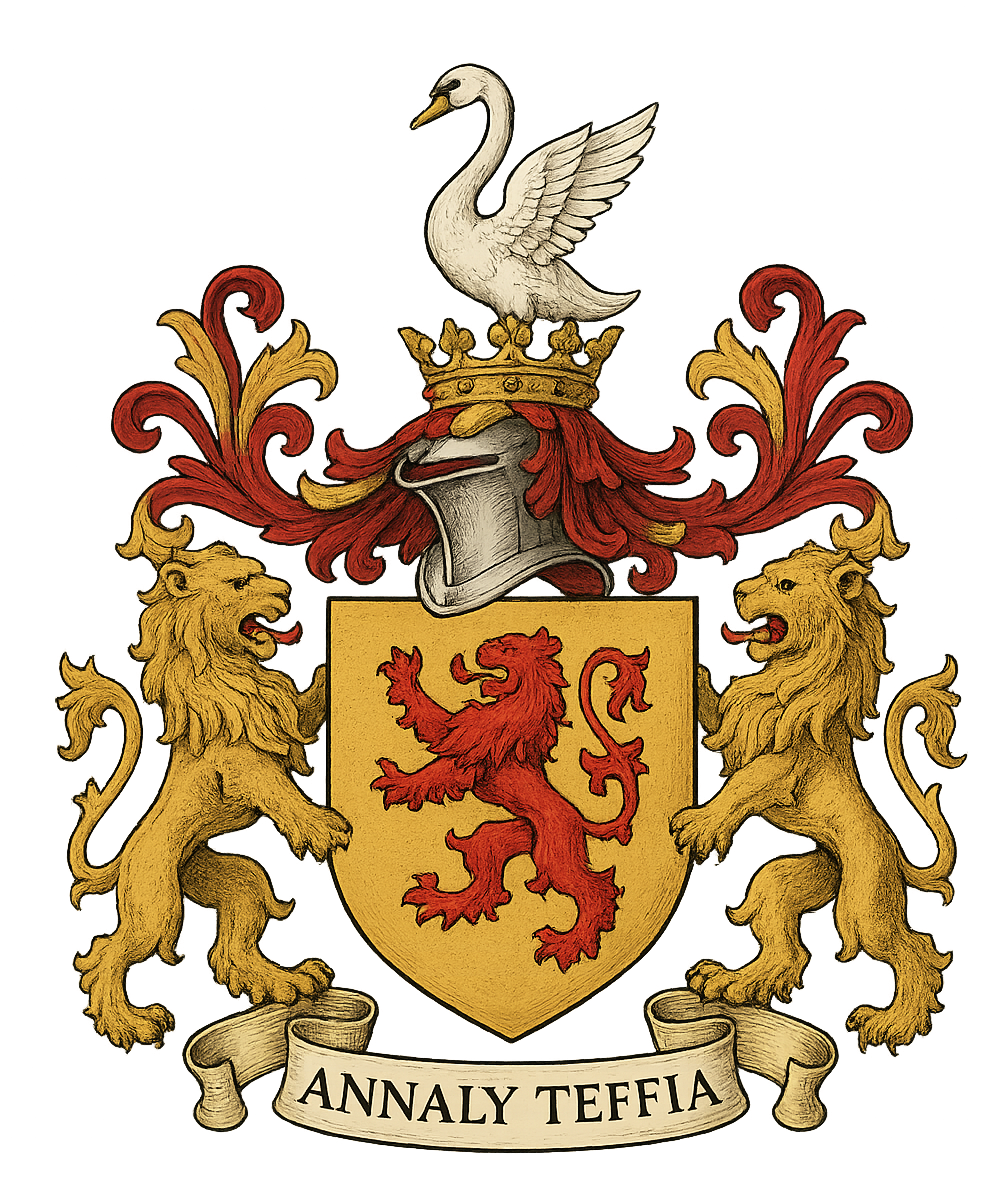Honour of Annaly - Feudal Principality & Seignory Est. 1172






Abbey of All SaintsThe A bbey of All Saints , in an island in lake or Lough Ree, territory of Longford , founded by St. Kieran the Younger. The founding of the following abbeys can be traced to the reign of Tuathal II. The abbey of All Saints, in an island in lake Lough Ree, territory of Longford, founded by St. Kieran the Younger. Colgan observes that this abbey was called “Monasterium Inisense, or Insulense ;” and that there was a regular canon of this house, called Augustin Magraidin, who was a celebrated writer of the lives of the Irish saints, and that he had composed a chronicle of Ireland, down to 1405, when he died. Sir Christopher Nugent , 6th (or 14th) Baron Delvin (1544–1602) was an Irish nobleman and writer. He was arrested on suspicion of treason against Queen Elizabeth I of England , and died while in confinement before his trial had taken place. Christopher was the eldest son of Richard, 5th (or 13th) Baron Delvin, and Elizabeth, daughter of Jenico Preston, 3rd Viscount Gormanston, and widow of Thomas Nangle, styled Baron of Navan. Richard Nugent, fourth or twelfth Baron Delvin, was his great-grandfather. He succeeded to the title on the death of his father, on 10 December 1559, and during his minority was the ward of Thomas Ratcliffe, third earl of Sussex, for whom he conceived a great friendship.[1] He was matriculated a fellow-commoner of Clare Hall, Cambridge,[2] on 12 May 1563, and was presented to the queen when she visited the university in 1564; on coming of age, about November 1565, he repaired to Ireland, with letters of commendation from the queen to the lord deputy, Sir Henry Sidney, granting him the lease in reversion of the abbey of All Saints and the Captainship & custody of Sleaught-William in the Annaly, County Longford.
Event detail for site: All Saint's Priory1538: DissolutionThe priory had been officially dissolved 16 September, 1538, and the site and possessions were granted 4 February, 1539, to the mayor, etc. of Dublin. (E), (Med. religious houses, Ire., 172)
Other events in the history of this site
c.1166: Foundation - Canons of the order of Arrouaise were
installed here c. 1166 by Dermot Mac Murrough, king of Leinster. (Ware), (Med. religious houses,
171)
c.1166: - Dermot, in his charter, which was witnessed by Laurence, archbishop of Dublin, Kinad, bishop of Glendalough, and others, granted land called Ballidubgail with its men and appurtenances to his spiritual father and confessor, Edan, bishop of Louth, for the use of the canons of the church of the daughter of Zola, and their successors. A later charter of confirmation was granted by Henry II. (Dugdale, ii, 1039), (Med. religious houses, Ire., 171) 1216: - Soon after 1216, when the see of Glendalough was united to Dublin, Archbishop Henry of London made the prior and convent of the Island of St. Saviour at Glendalough subject to All Saint's, Dublin, confirmed by Gregory IX and Innocent V. (RPOS, pp.xxii and 100 - 1)(Med. religious houses, Ire., 171) 1234 - 44: - Theobald Walter (Butler) was granted land in the Steyn, near the priory in 1234 - 44. 1234 - 44: - Maurice Fitzgerald granted land to the west of Dublin. (Med. religious houses, Ire., 171) 1396: - In 1396, Richard Norreys, one of the canons, was accused of various felonies, and Wm. Reve, the prior, used unbecoming expressions to the chief justice in court, for which he was committed into custody, but the court found that he was not of sound mind, and he was pardoned after payment of a fine. (K (A)), (Med. religious houses, Ire., 171) 1468: Visitation - A visitation, held in 1468, by an official of the archbishop, was attended by the prior, William Stewnot, the sub-prior and four canons. (RPOS, 99, xxiii), (Med. religious houses, Ire., 172) 1474: - William Stewnot was selected to be on a commission to attend the king, and in 1474, parliament enacted that he and his convent might hav dealings with Irish enemies who surrounded some of the possessions (RPOS, xxiv., f.), (Med. religious houses, Ire., 172) 1506: - Nicholas was prior in 1506 1537 - 1538: Dissolution - Prior Walter Hancoke leased out a farm in 1537 and he, with the sub-prior and four canons, signed the deed of surrender of the priory and its possessions 16 November 1538. (RPOS, xxvii, xxix).(Med. religious houses, Ire., 172) 1538: Dissolution - The priory had been officially dissolved 16 September, 1538, and the site and possessions were granted 4 February, 1539, to the mayor, etc. of Dublin. (E), (Med. religious houses, Ire., 172) 1538: - The priory had possessions in the counties of Meath, Dublin, Kildare, Louth, Tipperary and elsewhere in Ireland. (Morrin, i), (Med. religious houses, Ire., 172) 1548: - Prior Walter died in 1548(A), (Med. religious houses, Ire., 172) 1548: - An inquisition found that All Hallows had been seized of the nunnery or cell of Lusk, which, having been appropriated to the priory, was afterwards transferred to Grace Dieu.(RPOS, xxx), (Med. religious houses, Ire., 172) 1565: - Possessions and the captainship of Slewaght within the Analy were granted to Lord Devlin in 1565. (Morrin, i, 500), (Med. religious houses, Ire., 172) 1591: - Queen Elizabeth erected the College of the Holy Trinity on the site of the priory in 1591. (Ware), (Med. religious houses, Ire., 172) 1763: - The rental of the estate was over £788 in 1763 (RPOS, lxvi), (Med. religious houses, Ire., 172)
Citation of chronology: http://monie.tth2.co.uk/event/1058
Titles Honors of Abbeys – The Abbot and Orders Titles and honors associated with an abbey can vary depending on its history, significance, and the religious order to which it belongs. Here are some common titles and honors: 1. Abbey: The main title associated with the institution itself. An abbey is typically a complex of buildings comprising a monastery or convent, centered around the church where religious services are conducted. 2. Abbot/Abbess : The spiritual leader of an abbey is called an abbot if male or an abbess if female. They are responsible for the governance of the abbey and the spiritual well-being of its members. 3. Monastic Orders: Some abbeys belong to specific monastic orders, such as the Benedictines, Cistercians, or Trappists. The affiliation with a particular order may confer additional titles or distinctions. 4. Papal Recognition: Particularly significant abbeys may receive recognition or special status from the Pope or the Vatican, such as being designated as a basilica or receiving papal privileges. 5. Royal Patrons: Throughout history, many abbeys have enjoyed the patronage of royalty or nobility. This patronage could come with additional honors, such as royal charters, endowments, or exemptions from certain taxes or obligations. 6. Historical Significance: Abbeys with a long and storied history may be designated as historical landmarks or heritage sites by governmental or non-governmental organizations. This recognition can come with preservation efforts and increased tourism. 7. Cultural Contributions: Some abbeys have made significant cultural contributions through art, music, literature, or scholarship. This can lead to honors such as being recognized as centers of cultural heritage or receiving awards for their contributions to the arts and sciences. 8. Educational Institutions: Certain abbeys have established schools, universities, or other educational institutions. These institutions may have their own honors and titles associated with academic achievements or contributions to education. These titles and honors reflect the diverse roles that abbeys have played throughout history, encompassing spiritual, cultural, educational, and social dimensions.
|
About Longford Feudal Prince Statutory Declaration by Earl Westmeath Kingdoms of County Longford Pedigree of Longford Annaly What is the Honor of Annaly The Seigneur Lords Paramount Ireland Market & Fair Chief of The Annaly Lord Governor of Annaly Prince of Annaly Tuath Principality Feudal Kingdom Fons Honorum Seats of the Kingdoms Clans of Longford Region History Chronology of Annaly Longford Hereditaments Captainship of Ireland Princes of Longford News Feudal Princes Principality of Cairbre-Gabhra Count of the Palatine of Meath 850 Years Irish Property Law Manors Castles and Church Lands A Barony Explained Moiety of Barony of Delvin Spiritual & Temporal Islands of The Honour of Annaly Longford Blood Dynastic Water Rights Annaly Writs to Parliament Moiety of Ardagh Dual Grant from King Philip of Spain Rights of Lords & Barons Princes of Annaly Pedigree Abbeys of Longford Styles and Dignities Ireland Feudal Titles Versus France & Germany Austria Sovereign Title Succession Grants to Delvin Lord of St. Brigit's Longford Abbey Est. 1578 Feudal Barons Water & Fishing Rights Ancient Castles and Ruins Honorifics and Designations Kingdom of Meath Feudal Westmeath Seneschal of Meath Lord of the Pale Irish Gods The Feudal System Baron Delvin Kings of Hy Niall Colmanians Irish Kingdoms Order of St. Columba Chief Captain Kings Forces Commissioners of the Peace Tenures Abolition Act 1662 - Rights to Sit in Parliament Contact Law of Ireland List of Townlands of Longford Annaly English Pale Court Barons Lordships of Granard Irish Feudal Law Datuk Seri Baliwick of Ennerdale Moneylagen Lord Baron Longford Baron de Delvyn Longford Map Lord Baron of Delvin Baron of Temple-Michael Baron of Annaly Kingdom Annaly Lord Conmaicne Baron Annaly Order of Saint Patrick Baron Lerha Granard Baron AbbeyLara Baronies of Longford Princes of Conmhaícne Angaile or Muintir Angaile Baron Lisnanagh or Lissaghanedan Baron Moyashel Baron Rathline Baron Inchcleraun HOLY ISLAND Quaker Island Longoford CO Abbey of All Saints Kingdom of Uí Maine Baron Dungannon Baron Monilagan - Babington Lord Liserdawle Castle Baron Columbkille Kingdom of Breifne or Breny Baron Kilthorne Baron Granarde Count of Killasonna Baron Skryne Baron Cairbre-Gabhra AbbeyShrule Events Castle Site Map Disclaimer Irish Property Rights Indigeneous Clans Dictionary Maps Honorable Colonel Mentz Valuation of Principality & Barony of Annaly Longford
Feudal Baron of Longford Annaly - Baron Longford Delvin Lord Baron &
Freiherr of Longford Annaly Feudal Barony Principality Count Kingdom of Meath - Feudal Lord of the Fief
Blondel of the Nordic Channel Islands Guernsey Est. 1179 George Mentz
Bio -
George Mentz Noble Title -
George Mentz Ambassador - Order of the Genet
Knighthood Feudalherr - Fief Blondel von der Nordischen
Insel Guernsey Est. 1179 * New York Gazette ®
- Magazine of Wall Street - George
Mentz - George
Mentz - Aspen Commission - Ennerdale - Stoborough - ESG
Commission - Ethnic Lives Matter
- Chartered Financial Manager -
George Mentz
Economist -
George Mentz Ambassador -
George Mentz - George Mentz Celebrity -
George Mentz Speaker - George Mentz Audio Books - George Mentz Courses - George Mentz Celebrity Speaker Wealth
Management -
Counselor George Mentz Esq. - Seigneur Feif Blondel - Lord Baron
Longford Annaly Westmeath
www.BaronLongford.com * www.FiefBlondel.com |





Commissioner George Mentz - George
Mentz Law Professor - George
Mentz Economist
George Mentz News -
George Mentz Illuminati Historian -
George Mentz Net Worth
The Globe and Mail George Mentz
Get Certifications in Finance and Banking to Have Career Growth | AP News